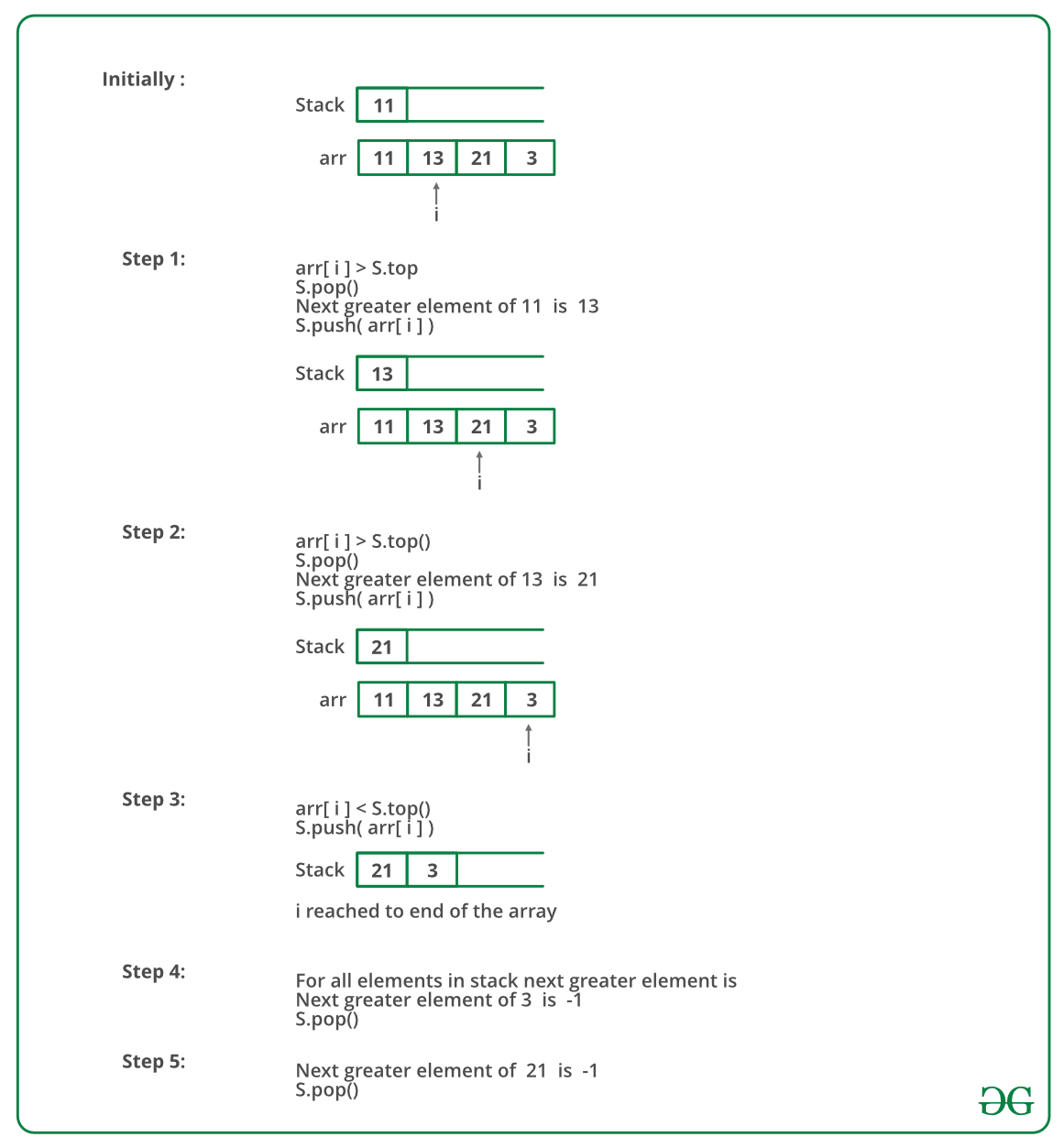寻找下一个更大元素的 C 程序
给定一个数组,打印每个元素的下一个更大元素 (NGE)。元素 x 的下一个更大元素是数组中 x 右侧的第一个更大元素。对于不存在更大元素的元素,将下一个更大的元素视为-1。
例子:
- 对于数组,最右边的元素总是具有下一个更大的元素为 -1。
- 对于按降序排序的数组,所有元素的下一个较大元素为 -1。
- 对于输入数组 [4, 5, 2, 25],每个元素的下一个更大的元素如下。
Element NGE
4 --> 5
5 --> 25
2 --> 25
25 --> -1d)对于输入数组 [13, 7, 6, 12},每个元素的下一个更大的元素如下。
Element NGE
13 --> -1
7 --> 12
6 --> 12
12 --> -1方法1(简单)
使用两个循环:外部循环一一挑选所有元素。内循环为外循环选取的元素寻找第一个更大的元素。如果找到更大的元素,则将该元素打印为下一个,否则打印-1。
下面是上述方法的实现:
C
// Simple C program to print next greater elements
// in a given array
#include
/* prints element and NGE pair for all elements of
arr[] of size n */
void printNGE(int arr[], int n)
{
int next, i, j;
for (i=0; i C
// A Stack based C program to find next
// greater element for all array elements.
#include
#include
#include
#define STACKSIZE 100
// stack structure
struct stack {
int top;
int items[STACKSIZE];
};
// Stack Functions to be used by printNGE()
void push(struct stack* ps, int x)
{
if (ps->top == STACKSIZE - 1) {
printf("Error: stack overflown");
getchar();
exit(0);
}
else {
ps->top += 1;
int top = ps->top;
ps->items[top] = x;
}
}
bool isEmpty(struct stack* ps)
{
return (ps->top == -1) ? true : false;
}
int pop(struct stack* ps)
{
int temp;
if (ps->top == -1) {
printf("Error: stack underflow n");
getchar();
exit(0);
}
else {
int top = ps->top;
temp = ps->items[top];
ps->top -= 1;
return temp;
}
}
/* prints element and NGE pair for all elements of
arr[] of size n */
void printNGE(int arr[], int n)
{
int i = 0;
struct stack s;
s.top = -1;
int element, next;
/* push the first element to stack */
push(&s, arr[0]);
// iterate for rest of the elements
for (i = 1; i < n; i++) {
next = arr[i];
if (isEmpty(&s) == false)
{
// if stack is not empty, then pop an element
// from stack
element = pop(&s);
/* If the popped element is smaller than next,
then a) print the pair b) keep popping while
elements are smaller and stack is not empty
*/
while (element < next) {
printf("n %d --> %d", element, next);
if (isEmpty(&s) == true)
break;
element = pop(&s);
}
/* If element is greater than next, then push
the element back */
if (element > next)
push(&s, element);
}
/* push next to stack so that we can find
next greater for it */
push(&s, next);
}
/* After iterating over the loop, the remaining
elements in stack do not have the next greater
element, so print -1 for them */
while (isEmpty(&s) == false)
{
element = pop(&s);
next = -1;
printf("n %d --> %d", element, next);
}
}
/* Driver code */
int main()
{
int arr[] = { 11, 13, 21, 3 };
int n = sizeof(arr) / sizeof(arr[0]);
printNGE(arr, n);
getchar();
return 0;
} 输出
11 -- 13
13 -- 21
21 -- -1
3 -- -1时间复杂度: O(N 2 )
辅助空间: O(1)
方法2(使用堆栈)
- 将第一个元素推入堆栈。
- 一个一个地选择其余的元素,然后循环执行以下步骤。
- 将当前元素标记为next 。
- 如果 stack 不为空,则将 stack 的顶部元素与next进行比较。
- 如果 next 大于顶部元素,则从堆栈中弹出元素。 next是弹出元素的下一个更大的元素。
- 当弹出的元素小于next时,继续从堆栈中弹出。 next成为所有此类弹出元素的下一个更大元素。
- 最后,压入栈中的下一个。
- 步骤 2 中的循环结束后,从堆栈中弹出所有元素并打印 -1 作为它们的下一个元素。
下图是上述方法的试运行:

下面是上述方法的实现:
C
// A Stack based C program to find next
// greater element for all array elements.
#include
#include
#include
#define STACKSIZE 100
// stack structure
struct stack {
int top;
int items[STACKSIZE];
};
// Stack Functions to be used by printNGE()
void push(struct stack* ps, int x)
{
if (ps->top == STACKSIZE - 1) {
printf("Error: stack overflown");
getchar();
exit(0);
}
else {
ps->top += 1;
int top = ps->top;
ps->items[top] = x;
}
}
bool isEmpty(struct stack* ps)
{
return (ps->top == -1) ? true : false;
}
int pop(struct stack* ps)
{
int temp;
if (ps->top == -1) {
printf("Error: stack underflow n");
getchar();
exit(0);
}
else {
int top = ps->top;
temp = ps->items[top];
ps->top -= 1;
return temp;
}
}
/* prints element and NGE pair for all elements of
arr[] of size n */
void printNGE(int arr[], int n)
{
int i = 0;
struct stack s;
s.top = -1;
int element, next;
/* push the first element to stack */
push(&s, arr[0]);
// iterate for rest of the elements
for (i = 1; i < n; i++) {
next = arr[i];
if (isEmpty(&s) == false)
{
// if stack is not empty, then pop an element
// from stack
element = pop(&s);
/* If the popped element is smaller than next,
then a) print the pair b) keep popping while
elements are smaller and stack is not empty
*/
while (element < next) {
printf("n %d --> %d", element, next);
if (isEmpty(&s) == true)
break;
element = pop(&s);
}
/* If element is greater than next, then push
the element back */
if (element > next)
push(&s, element);
}
/* push next to stack so that we can find
next greater for it */
push(&s, next);
}
/* After iterating over the loop, the remaining
elements in stack do not have the next greater
element, so print -1 for them */
while (isEmpty(&s) == false)
{
element = pop(&s);
next = -1;
printf("n %d --> %d", element, next);
}
}
/* Driver code */
int main()
{
int arr[] = { 11, 13, 21, 3 };
int n = sizeof(arr) / sizeof(arr[0]);
printNGE(arr, n);
getchar();
return 0;
}
输出
11 --> 13
13 --> 21
3 --> -1
21 --> -1时间复杂度: O(N)
辅助空间: O(N)
最坏的情况发生在所有元素都按降序排序时。如果元素按降序排序,则每个元素最多处理 4 次。
- 最初推入堆栈。
- 处理下一个元素时从堆栈中弹出。
- 因为下一个元素更小,所以被推回堆栈。
- 在算法的第 3 步中从堆栈中弹出。
请参阅以相同顺序打印的优化解决方案。
有关详细信息,请参阅有关 Next Greater Element 的完整文章!